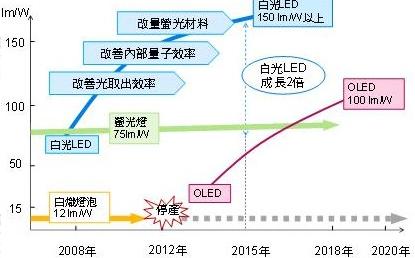 According to DIGITIMES Research, under the global environmental protection and energy saving green appeal, solid-state lighting has become a new trend in the future. In 2011, LED lighting gradually entered the mainstream market, gradually replacing traditional lighting, and another solid-state lighting technology - OLED lighting, Due to its excellent color rendering performance and its surface glow, it can not only exhibit natural and soft light, but also has a large space for use in shape design, and has become a developed focus of advanced countries.
According to DIGITIMES Research, under the global environmental protection and energy saving green appeal, solid-state lighting has become a new trend in the future. In 2011, LED lighting gradually entered the mainstream market, gradually replacing traditional lighting, and another solid-state lighting technology - OLED lighting, Due to its excellent color rendering performance and its surface glow, it can not only exhibit natural and soft light, but also has a large space for use in shape design, and has become a developed focus of advanced countries. The EU proposed OLED 100. Eu project aims to achieve luminescence efficiency of 100 lm/W in OLED lighting in September 2011, a lifetime of 100,000 hours, an area of ​​100 x 100 square centimeters and a cost of less than 100 euros per square meter, but due to technical developments that are not as expected, The efficiency target has been revised from 100 lm/W to more than 60 lm/W. This program has a total of 14 companies or research units participating in 6 countries in Europe.
Japan's OLED lighting development is part of the basic science and technology plan. During the period from 2006 to 2010, the third phase of the science and technology basic plan, a total of three major OLED lighting plans, and in 2010 Japan's OLED lighting test luminous efficiency Up to 20 lm/W. In the development of OLED lighting in Japan, special emphasis is placed on the use of the surface. Although early lighting efficiency is not high, it can be used in applications such as automotive dashboards or entertainment lighting that require low brightness.
South Korea is another Asian country that is actively developing OLED lighting. Its leading units for OLED lighting research and development include the Korea Institute of Advanced Manufacturing Technology, the Korea Electronic Communications Research Institute, and the Korean Panel Industry Association. The cooperation units include SMD, LG Chemicals, and Kumho Electronics. For large plants, the longest planning period is 7 years. It is dominated by the Korea Institute of Advanced Manufacturing Technology and started in 2006. It expects to achieve the luminous efficiency of 100 lm/W in 2012.
Pvc Dipping,Pvc Dipping Process,Pvc Dipping Machine,Pvc Dipping Station
GSDGH , http://www.nbrigidbusbar.com